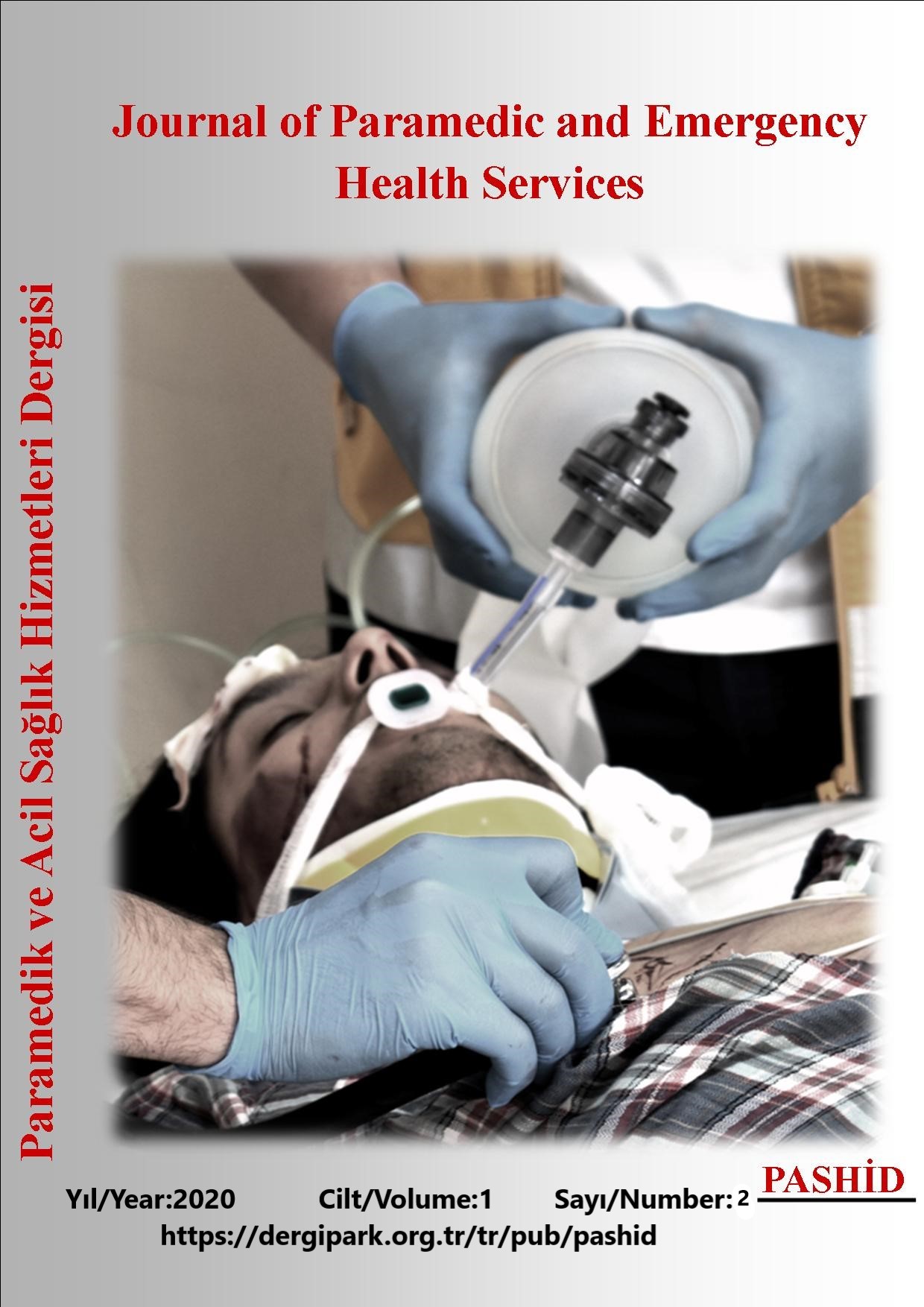Gümüşhane İli 112 Acil Sağlık Hizmetleri İstasyonlarında Çalışan Personelin Crush Sendromu Bilgi Düzeyleri
Bu araştırmanın amacı Gümüşhane 112 acil sağlık hizmetleri istasyonlarında çalışan personelin Crush Sendromu konusundaki bilgi düzeylerini ve başta eğitim olmak üzere bazı ilişkili etmenleri ortaya koymaktır. Bu araştırma kesitsel nitelikte analitik bir araştırmadır. Araştırmanın evrenini Gümüşhane 112 acil sağlık hizmetleri istasyonlarında çalışan personelin tamamı (200 kişi) oluşturmuştur. 200 kişiden 132’sine (%66) ulaşılmıştır. Bağımlı değişken olan Crush Sendromu bilgi düzeyi 20 soru ile 100 puan üzerinden değerlendirilmiştir. Veriler araştırmacı tarafından oluşturulan anket aracılığı ile toplanmıştır. Veriler bilgisayarda SPSS 16.0 paket programı aracılığı ile değerlendirilmiştir. İstatistiksel analizlerde Kruskal Wallis Varyans analizi ve Student’s t-testi kullanılmıştır. Anlamlılık sınırı p≤0,05 olarak alınmıştır. Araştırmaya katılan 132 personelin yaş ortalaması 28,8±6,5 olarak bulunmuştur. Araştırma grubundaki kişilerin %56,06’sı kadın, %43,93’ü erkektir. Crush Sendromu genel bilgi düzeyi ortalaması 43,93 ±6,5 puandır. Personelin Crush Sendromu bilgi düzeyi ile Crush Sendromu eğitimi alma durumu (p
Anahtar Kelimeler:
Crush Sendromu, 112 Acil Sağlık Hizmetleri, Crush Sendromu Eğitimi
Crush Syndrome Knowledge Levels of Personnel Working At 112 Emergency Health Service Stations of Gümüşhane Province
The aim of this study is to reveal the level of knowledge of Crush Syndrome among staff working at Gümüşhane 112 emergency health service stations and some related factors, especially education. This study is an analytic cross sectional research. All of the personnel (200 persons) working in Gumushane 112 emergency health service stations constituted the universe of the research. 132 out of 200 people (66%) were reached. The level of knowledge of Crush Syndrome, which is the dependent variable, was evaluated with 20 questions and 100 points. The data were collected through a questionnaire created by the researcher. The data were evaluated on the computer through the SPSS 16.0 package program. Kruskal Wallis analysis of variance and Student’s t-test were used for statistical analysis. The significance limit was taken as p≤0.05. The average age of the 132 personnel who participated in the survey was 28.8 ± 6.5. 56.06% of the participants were women and 43.93% were man. The average of Crush Syndrome knowledge level was 43.93 ± 6.5. There was a significant difference between Crush Syndrome knowledge level of the personnel and Crush Syndrome training status (p
___
- AFAD. (2021, Ağustos 15). Deprem Sonrası İlk 6 Saat. hazirol.gov.tr: https://www.hazirol.gov.tr/ adresinden alındı
- Afet ve Acil Durum Müdürlüğü [AFAD]. (2021, Ağustos 15). Afet Farkındalık Eğitimi. hazirol.gov.tr: https://www.hazirol.gov.tr/ adresinden alındı
- Bywaters, E. G. (1990). 50 years on: the crush syndrome. BMJ: British Medical Journal, 301(6766), 1412–1415.
- Bywaters, E., & Beall, D. (1941). Crush Injuries with Impairment of Renal Function. British Medical Journal, 1(4185), 427-432.
- Chen, Y.-E., Li, C., Chang, C.-P., & Zheng, M. (2021). Identifying the influence of natural disasters on technological innovation. Economic Analysis and Policy(70), 22-36.
- Cutter, S. L., Tiefenbacher, J., & Solecki, W. D. (1992). En-gendered fears: Femininity and technological risk perception. Industrial Crisis Quarterly, 6(1), 5-22.
- Çelebi, İ., & Uçku, Ş. R. (2017). Kayseri 112 Acil Sağlık Hizmetlerinde Görev Yapan Sağlık Personelinin Deprem Bilgi Düzeyi ve Etkileyen Etmenler. Hastane Öncesi Dergisi, 2(2), 91-103.
- Erdoğan, Ö. (2018). Afet Hemşireliği Eğitimi. S. Öztekin (Dü.) içinde, Afet Hemşireliği (s. 115-120). Ankara: Türkiye Klinikleri. Flynn, J., Slovic, P., & Mertz, C. K. (1994). Gender, race, and perception of environmental health risks. Risk analysis, 14(6), 1101-1108.
- Fothergill, A. (1996). Gender, risk, and disaster. International journal of mass emergencies and disasters, 14(1), 33-56. Göktekin, Z. (2018). 112 Acil Sağlık Hizmetleri Çalışanlarının Afet Bilinç Algı Düzeylerinin Belirlenmesi; Balıkesir İli Örneği. Yüksek Lisans Tezi. Çanakkale: Çanakkale Onsekiz Mart Üniversitesi Eğitim Bilimleri Enstitüsü.
- Gündüz Akan, F. (2018). İzmir İli 112 Ambulans Servisi Çalışanlarının Sahada Crush (Ezilme) Sendromu Tedavisi Hakkında Bilgi Düzeylerinin Değerlendirilmesi. Yüksek Lisans Tezi, 59.
- Güner, Y. (2016). Çanakkale İli 112 Acil Sağlık Hizmetleri İstasyonlarında Çalışan Personelin Afet Tıbbı Konusundaki Bilgi Düzeyleri. Yüksek Lisans Tezi. Denizli: Pamukkale Üniversitesi Sağlık Bilimleri Enstitüsü.
- Ho, M.-C., Shaw, D., Lin, S., & Chiu, Y.-C. (2008). How Do Disaster Characteristics Influence Risk Perception? Risk Analysis, 28(3), 635-643.
- Koçak, M. (2019). Ulusal ve Ulusararası Afet Eğitimi. D. Özüçelik (Dü.) içinde, Afetlerde Acil Tıp Hizmetleri (s. 89-96). Ankara: Türkiye Klinikleri.
- Kung, Y.-W., & Chen, S.-H. (2012). Perception of Earthquake Risk in Taiwan: Effects of Gender and Past Earthquake Experience. Risk Analysis, 32(9), 1535-1546.
- Lovekamp, W. E. (2006). Gender, race/ethnicity and social class differences in disaster preparedness, risk and recovery in three earthquake-stricken communities. Doktora Tezi. Southern Illinois University at Carbondale.
- Oda, J., Tanaka, H., Yoshioka, T., Iwai, A., Yamamura, H., Ishikawa, K., . . . Sugimoto, H. (1997). Analysis of 372 Patients with Crush Syndrome Caused by the Hanshin-Awaji Earthquake. The Journal of Trauma: Injury, Infection, and Critical Care, 42(3), 470-476.
- Sever, M. Ş., & Vanholder, R. (2013). Management of Crush Victims in Mass Disasters: Highlights from Recently Published Recommendations. Clinical Journal of the American Society of Nephrology, 8(2), 328-335.
- Sever, M. Ş., Erek, E., Vanholder, R., Özener, Ç., Yavuz, M., Ergin, H., . . . Lameire, N. (2002). The Marmara earthquake: admission laboratory features of patients with nephrological problems. Nephrology Dialysis Transplantation, 17(6), 1025-2031.
- Vanholder, R., van der Tol, A., De Smet, M., Hoste, E., Koç, M., Hussain, A., . . . Sever, M. S. (2007). Earthquakes and crush syndrome casualties: Lessons learned from the Kashmir disaster. Kidney international, 71(1), 17-23.
- ISSN: 2717-798X
- Yayın Aralığı: Yılda 2 Sayı
- Başlangıç: 2020
Sayıdaki Diğer Makaleler
Sağlık Bilimleri Fakültesi Öğrencilerinde Covıd-19 Korkusu
Sümeyye AHİ, Barış ÇIPLAK, Arda BORLU, Halime AYDEMİR, Fatma ERGÜN
Mustafa ATCI, Mahmut Sami TUTAR, Osman Mücahit TOSUN, Aslı ALTINORDU ATCI, Mehmet Nurullah ARIKAN
Üniversite Hastanesinde Çalışan Hemşirelerde İş Kazası Sıklığı ve Etkileyen Etmenler
Esra ÖZPOLAT ÖZGÜN, Saime ŞAHİNÖZ, Zekiye GÖKTEKİN
Türkiye’de Yapılmış Nomofobi Konulu Lisansüstü Tezlerin İncelenmesi
Mehmet Erdem GÜNEY, Mustafa İLHAN
Tıbbi Laboratuvarlarda Meydana Gelen Hatalar: Preanalitik Süreç ve Önlemler
